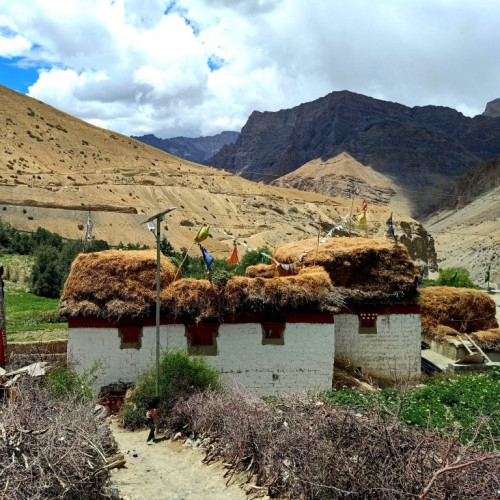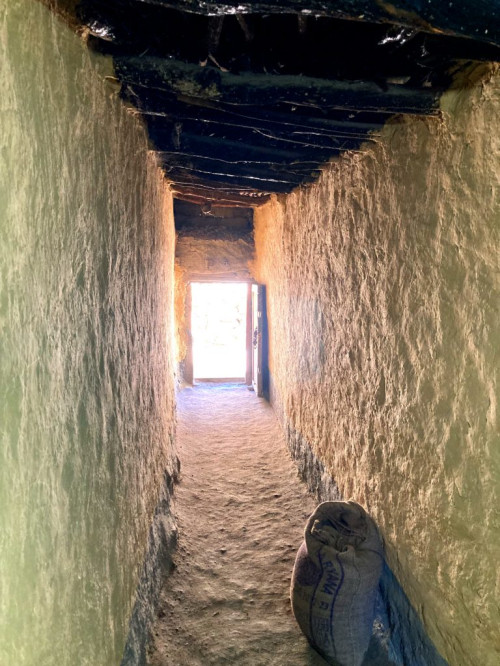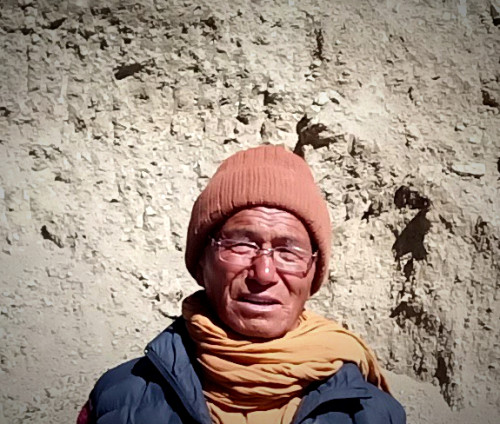
Introduction
Join us for a unique opportunity to be part of a natural building workshop in the Spit Valley, Northern India. This vernacular architectural workshop will take place during the restoration and adaptive reuse of a 150 yr old rammed earth home in Kwang village. During the workshop you will be participating and learning by doing. Under the guidance of experienced Master Artisan Lhama Tamo we will be rebuilding damaged rammed earth walls, raising the ground floor ceiling and first floor, inserting larger windows & plastering internal walls.
You will learn the ancient wisdom that enabled the people of the Spiti Valley to inhabit this harsh landscape with an extreme climate for thousands of years. The restoration will be done using locally available materials as they always have. Adaptations and changes will be made to structure in order to make it suitable for modern standards of living.

The Vernacular Architecture of the Spiti Valley is bio-climatically designed and reflects the local Tibetan Buddhist culture.
Meet the Master Craftsman – Lama Thamo

As his name suggests Lama Thamo was once a monk. According to local custom in Spiti the youngest son in each home normally becomes a monk. At the young age of 6 yrs old Lama Thamo joined the Ki Gompa and was ordained as a monk. For the next 20 years Ki Gompa remained his home and monastic life his world.
In his role at the monastery he took up rammed earth construction at the age of 15. During his time at the Gompa he built and maintained numerous structures. At the age of 25 he decided to leave the Gompa to marry and have a family. His time living a monastic life has undoubtedly left its mark on him. He is a kind and gentle being always smiling and joyful. Time in his presence energises ones soul.
Workshop Content
- Rammed Earth construction according to the traditional practice in Spiti Valley
- Identifying the correct soil and making amendments as needed
- The role and importance of aggregates
- Appropriate moisture content of soil for highest quality rammed earth
- How to install and work with shuttering for rammed earth
- How to use ones body or a barley grain
as a tool for measurement
- How to construct a flat mud roof
- Material selection – how to select structural timber, how to harvest wild plants for use in a flat mud roof
- Appropriate soil selection for various construction uses – flooring, plasters, roofing & waterproofing
- How to install windows and door frames & niches in rammed earth walls
- How to make adobes (sun baked bricks)
- Troubleshooting common problems in rammed earth construction
- Structural considerations with Rammed earth construction
- Earthquake resilient design
*** Architecture Workshop content will vary according to the stage of the construction at time of workshop. However we will strive to offer as diverse range of exposure to local techniques as possible.
***Those wishing to learn in a more intensive manner by volunteering before or after the architecture workshop are encouraged to get in touch to explore opportunities.
Our Hosts in Spiti Valley
Indi Architecture – Kimberley, Karanbir & Thanpa ji
This is our very own restoration project so we will be your hosts along with Thanpa ji who is the owner of the heritage house under restoration, which is his ancestral property.
We have years of experience in the field of hospitality and strive to make your stay memorable. However you should be prepared for the realities of living in a remote location such as Spiti. Power cuts are frequent, sometimes for days. We will make sure that there is a source for charging phones and cameras. Water is a precious resource that we should all do our best to conserve.
We will provide you with 3 simple vegetarian meals per day as well as morning and afternoon tea. The local water is as fresh as it gets and we prefer to drink it fresh from the springs however a filter will also be available for those who prefer it.
We request you to bring your own sleeping bag and towel. Other bedding will be provided.
About the Heritage Restoration Project
Spiti Valley is currently undergoing a period of rapid transformation. Tourism is booming and many locals as well as those from further afield are seeking opportunities to be a part of the boom. Unfortunately this has resulted in the destruction of precious cultural heritage in the form of vernacular architecture.
The main town of Kaza is now a concrete jungle with multi storey Reinforced Cement Concrete (RCC) structures dominating the landscape. We believe these changes are taking place because there is a misperception that tourist want to stay in ‘modern’ structures just like the ones they come from in the city. To an extent that may true, however from our experience as world travellers we know the most fascinating places to travel are those where cultural heritage remains strong.
Our intention with this heritage restoration project is to provide modern comfort in a heritage structure. We would like to use this home as a demonstration site showing how adaptations can be made to traditional homes providing all of the elements people are seeking in RCC structures. In doing so we hope to contribute to the conservation of the precious cultural heritage of the region and reduce the influx of unsustainable and climatically inappropriate materials from the cities below.
The home undergoing restoration is a very humble 150 year old home. Whilst there are many homes in the valley that have higher levels of ornamentation and character we specifically chose this property for three main reasons.
Firstly Thanpa ji was already in the process of tearing it down to replace it with something new, when we heard about – therefore it was in immediate need of protection. Secondly it is an exceptional example of bio-climatic design. This home demonstrates the intelligence of the designers in this remote region 150 years ago.
Prior to the advent of mechanical heating and cooling vernacular artisans by necessity learned over generations how best to employ locally abundant resources to build homes that provided the greatest level of human comfort with the least resources. A skill that is almost entirely absent from most modern architectural designs that without heating or cooling are uninhabitable for many months of the year.
The third and final consideration for the selection of this home is the stunning location at the end of a six house village with a sense of solitude and views that make you never want to leave. Located on the opposite side of the river bank to Kaza the southerly view of the house faces the Spiti river valley towards the permanently snow capped Manirang peak (6593m). The peace and solitude of the home makes this the perfect Spiti getaway.
Upon completion this home will be offered as a tourism property wherein guests will be able to rent the entire home for a unique Spiti experience. To truly experience the beauty of life in Spiti, one needs to spend time in her villages. We will be offering that chance with a level of comfort and privacy not previously available.
Inclusions & Cost – Architecture Workshop
- Transfer from Kaza to Kwang Village
- Participation in a small group workshop with a maximum of 16 participants
- Ample opportunity for one on one interaction with Master Artisan Lama Thamo
- 9 Days of practical hands on learning by doing
- One day tour to explore Lalung Village including a tour of an exceptionally well maintained heritage house.
- Theory sessions & discussion related to bio – climatic design, rammed earth, heritage conservation, vernacular architecture, intangible cultural heritage & architectural change in the Spiti Valley
- 10 nights accommodation in traditional rammed earth home in dormitory style accommodation
- Three simple vegetarian meals per day including morning and afternoon tea.
We will be staying in a traditional rammed earth home in Kwang village, directly opposite the house under restoration You will have a chance to experience the beauty and warmth of living in a hand crafted earthen home, Spiti Style. Accommodation will be in dormitories with separate rooms for men and women.
This is a traditional home so you will need to be comfortable with the traditional dry composting toilet system. This is the most sustainable form of toilet system anywhere. Rather than creating waste this system generates a precious resource – humanure. Spiti Valley is a high altitude desert and water a precious resource. We admire the intelligence of traditional systems in Spiti Valley and their indigenous toilet system is one of them.
Optional Two night / Three Day Architectural Tour – Pick up from Shimla 6th June
Spend three days exploring the culture & vernacular architectural traditions of Kinnaur & Spiti Valley as you make your way up for the workshop. We will pick you up in Shimla and show you some of our favourite hidden architectural gems along the way. We might be biased but we believe that wherever architectural traditions remain strong, so does culture this makes for a fascinating travel adventure.
Inclusions & Cost (minimum 10 participants required)
- Twin Share accommodation for two nights
- Day 1 Rampur – HP Tourism Hotel
- Day 2 Pooh – Om Guest House
- Private vehicle transfer – depending on numbers, may be an Innova / Pajero / Tempo Traveller
- Personally guided by Kimberley
- Visit Ropa valley, Moorang, Kanom Monastery & Tabo
- We will take you to places few tourists know about and share with you some precious architectural treasures.
On leaving the Gompa Lama Thamo took up rammed earth construction full time and spent the next 40 yrs perfecting his technique. He is famous throughout Spiti Valley for his precision rammed earth. Achieved, he claims, by adjusting the external formwork inwards by the width of one barley grain each time! We are excited to have him with us, now in his 60s he has retired but remains in high demand.
Lama Thamo will be guiding the entire build and the natural building workshop with a team of his own artisans. He is a generous teacher committed to sharing his wisdom with all to ensure it gets carried forward for future generations.